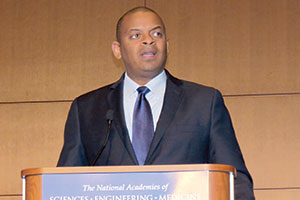Anthony Foxx Promotes Strategic Plan to Boost Freight Connectivity

WASHINGTON — Speaking in a packed ballroom at the Transportation Research Board’s annual meeting Jan. 13, Secretary of Transportation Anthony Foxx touted “the real possibility that we can go from bottlenecks to relief” through his department’s National Freight Strategic Plan, which was released in October.
Foxx said the plan can unlock “a system that’s multimodal, that has very distinct bottlenecks and gaps, and [lacks coherent] decision-making processes such as the fact that we basically have 52 different freight systems, making it difficult [to see] how the system all works together.”
The plan, announced two months before the FAST Act became law Dec. 18, aims to encourage states to look beyond their boundaries to solve transportation problems and to think longer term as part of a system that annually moves more than 55 million tons of goods worth nearly $50 billion. It calls for funding dedicated to freight projects, identifies major corridors and gateways, offers ways to improve data collection and analysis to measure freight movement and suggests programs to train future freight transportation workers in skills for fast-changing technologies.
Foxx said that, even if DOT had gotten all of its wish list into the FAST Act, the first long-term transportation funding legislation this decade, the nation still would face the daunting challenge of moving 70 million more people and the goods they use over the next 30 years. That’s what prompted DOT to issue the Freight Strategic Plan.
“We’re going to continue do the work of transforming our government for the 21st century . . . [with] innovation and technology that will improve people’s lives and connect them to opportunities,” Foxx said, continuing the president’s theme that the administration won’t stand down as it enters the final year of its tenure.
One example of moving ahead is DOT’s Smart City Challenge, which Foxx announced last month and which he said will produce “one winner but a lot of right answers.”
Cities with populations between 200,000 and 850,000 can compete for $50 million in transportation funding in the Smart City Challenge. The five cities that submit applications by Feb. 4 with the most innovative plans to harness technology that helps develop new mobility strategies will be chosen in May, with the winner announced in June.
Foxx spent much of his TRB address getting personal, looking back on his roots in a Charlotte, North Carolina, neighborhood sandwiched between Interstate 77 and I-85. Foxx, who served as Charlotte’s mayor from 2009 to 2013, criticized previous generations of transportation planners for separating poor, minority-dominated neighborhoods from the rest of their cities with freeways, helping to cause inequality and the loss in the belief in the American dream, what he called “structural discrimination.”
“We should talk about taking people beyond their doorstep[s] to opportunity, but we should also talk about bringing opportunity to their doorstep,” said Foxx, citing highways in Baltimore, Syracuse, New York, and Staten Island, New York, for serving as pass-throughs rather than connective tissue while also praising Columbus, Ohio, and Rochester, New York, for removing such barriers.
“The lines we draw with infrastructure are somehow infused with the attitudes we bring to the communities we affect. Transportation can help us solve the opportunity gap. We need to bring people together by design,” Foxx said.

